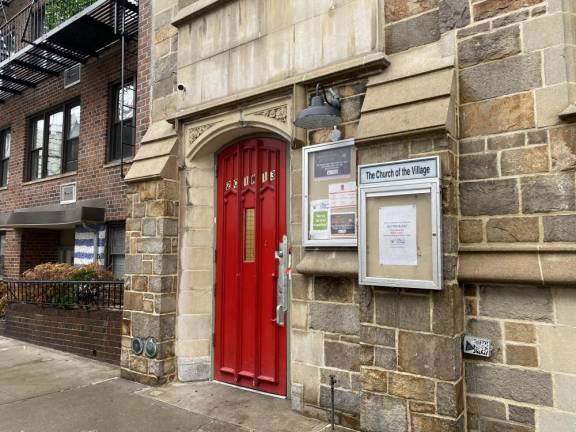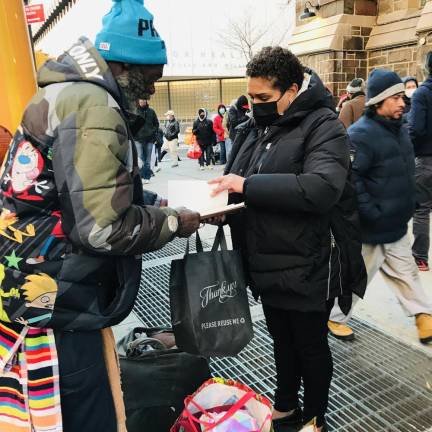The Door That Stayed Open During Lockdown
Meet the volunteer-based food kitchen that fed thousands during COVID-19
By just one year after NYC declared the pandemic a state of emergency on March 12, 2020, the number of New Yorkers experiencing food insecurity had increased by 36 percent – an estimated 1.5 to 2 million people, up from a pre-pandemic 1.2 million. That first year of lockdown led to a significant strain on even the largest emergency food programs and closed nearly 40% of the city’s food pantries and soup kitchens.
The Red Door Place wasn’t one of them. While the rest of us were stuck in the Groundhog Day that followed NYC’s official shutdown, a team of four remained at hard at work.
“We were here,” said Executive Director Teresa Concepcion of her small group of volunteers working out of The Church of the Village on 13th Street and Seventh Ave. “As a matter of fact, we had to be.”
Still in the rhythm of pre-pandemic routine, The Red Door Place maintained their biweekly schedule the entirety of lockdown, handing out meals on Tuesdays and Saturdays composed of fresh vegetables, meat, and milk— all part of the menu Concepcion transformed when she took over the program in 2016.
At the height of COVID in NYC, the program attracted 600-1000 guests on open days, prompting lines that circled the building and sometimes even the block. Running on short term grants, three paid staff, and a couple of brave volunteers, The Red Door Place managed not to turn away a single visitor.
“We had people from all walks of life that suddenly weren’t working,” Concepcion said. “It’s changed through the pandemic, the faces. They’re not just homeless.” From employees at the neighboring hospital to entertainment workers suddenly unemployed, The Red Door Place didn’t ask questions, never requiring so much as identification from guests in need— guests who came from everywhere. Concepcion remembers visitors coming in from Pennsylvania once a month, picking up pantry items to bring home to their families.
“The entire gym floor, that’s about 2400 square feet, was covered with food stacked 5 feet high”, she recalled from 2020. What had once been the site of weekly family-style meals was a dining-room-turned-pantry, a holding place for food that would continue to feed thousands of New Yorkers.
“Make Sure They Were Okay”
But the program refused to leave their community values in pre-pandemic days, and the relationships formed by Concepcion and her volunteers with the program’s guests were seldom forgotten.
“When someone was missing through the pandemic that was street homeless, we would go out in the neighborhood trying to find them to make sure they were okay,” she said. These were regulars Concepcion and her team knew by name, people who had met her family when they came to volunteer. In the most isolating time to be living in this city, The Red Door Place didn’t just feed their guests. They remembered them. “I’ve worked really hard to get rid of the stigma. Everybody is embarrassed to go to pantry except here.” she said. “One of the most important things for us is to make sure people feel normal.”
Talk of expanding The Red Door Place’s services in further efforts to help the community began pre-pandemic. Prior to the unexpected complications of 2020, the program offered career services and other support, with hopes to bring mental health professionals into the space as well. Concepcion’s newest project was to be in urban farming, growing fresh vegetables underground hydroponically. The end goal was to promote sustainability with produce that could be both sold and used in the food kitchen to keep costs low, while simultaneously engaging community member in the farming process.
While the project was thwarted by the pandemic it has not been forgotten, and in the next five years Concepcion hopes to make it a reality. “It has to be the way of the future now for people to be able to eat healthy,” she says. “There is no reason in this country that anyone should be hungry or not have access to food.” But she doesn’t mean just any food.
“Right now, at the farmers market, most people can’t afford the organic, wonderful stuff that’s there,” she says. “But if I teach people how to grow things, even if it’s just nutritious greens and edible flowers and medicinal plants, herbs and so forth, not only are you taking the upper hand for your own health, but you’re also raising your food, your access to food.”
Like many, she knows that while The Red Door Place and other emergency food services are necessary, they are not a permanent solution to the hunger crisis, hence the need for more thoughtful programs that focus on the roots of food insecurity. “I always say that the long-term goal is that we don’t exist because nobody’s hungry,” she says. “I don’t think that’s going to happen in my lifetime, but it’s a good dream to have.”
“We had people from all walks of life that suddenly weren’t working. It’s changed through the pandemic, the faces. They’re not just homeless.” Executive Director Teresa Concepcion

